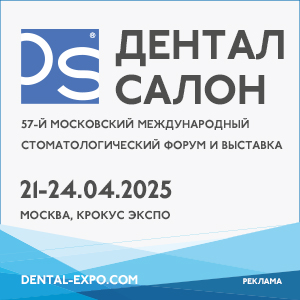DOI:
10.37988/1811-153X_2022_4_102Evaluation of regenerative processes by liquid cytology of tissues around dental implants after vestibuloplasty
Downloads
Abstract
The aim is to assess the intensity of epithelialization processes in the tissues of the vestibule of the mouth after vestibuloplasty based on liquid cytology data. >. The study included 60 patients with insufficient or completely absent area of the attached keratinized gum in the area of the installed dental implants. The patients were divided into 3 equal groups according to the type of material for closing the wound surface: I — free gingival graft, II — collagen matrix Mucosa, III — free skin flap (split dermal autograft from the anterior surface of the thigh). Liquid cytology was used to assess the state of tissue regeneration. The material was collected before the operation and 7, 14 and 30 days after it. >. By the 30th day after surgery, the highest rates of regeneration were observed after transplantation of free skin. The number of cells of multilayer squamous epithelium in smears was 99%, and when used — 91%, and when using Mucoderm — 85%. >. For the first time, the method of liquid cytology used to evaluate reparative processes in transplanted tissues has proven its viability and can be recommended for use in dentistry.Key words:
dental implant, keratinized gingiva, vestibuloplasty, liquid cytology, epithelizationFor Citation
[1]
Brailovskaya T.V., Kogan E.A., Shkvarkina E.A. Evaluation of regenerative processes by liquid cytology of tissues around dental implants after vestibuloplasty. Clinical Dentistry (Russia). 2022; 25 (4): 102—105. DOI: 10.37988/1811-153X_2022_4_102
References
- Ravidà A., Arena C., Tattan M., Caponio V.C.A., Saleh M.H.A., Wang H.L., Troiano G. The role of keratinized mucosa width as a risk factor for peri-implant disease: A systematic review, meta-analysis, and trial sequential analysis. Clin Implant Dent Relat Res. 2022; 24 (3): 287—300. PMID: 35298862
- Brito C., Tenenbaum H.C., Wong B.K., Schmitt C., Nogueira-Filho G. Is keratinized mucosa indispensable to maintain peri-implant health? A systematic review of the literature. J Biomed Mater Res B Appl Biomater. 2014; 102 (3): 643—50. PMID: 24124021
- Thoma D.S., Naenni N., Figuero E., Hämmerle C.H.F., Schwarz F., Jung R.E., Sanz-Sánchez I. Effects of soft tissue augmentation procedures on peri-implant health or disease: A systematic review and meta-analysis. Clin Oral Implants Res. 2018; 29 Suppl 15: 32—49. PMID: 29498129
- Zucchelli G., Tavelli L., McGuire M.K., Rasperini G., Feinberg S.E., Wang H.L., Giannobile W.V. Autogenous soft tissue grafting for periodontal and peri-implant plastic surgical reconstruction. J Periodontol. 2020; 91 (1): 9—16. PMID: 31461778
- Dreyer H., Grischke J., Tiede C., Eberhard J., Schweitzer A., Toikkanen S.E., Glöckner S., Krause G., Stiesch M. Epidemiology and risk factors of peri-implantitis: A systematic review. J Periodontal Res. 2018; 53 (5): 657—681. PMID: 29882313
- Perussolo J., Souza A.B., Matarazzo F., Oliveira R.P., Araújo M.G. Influence of the keratinized mucosa on the stability of peri-implant tissues and brushing discomfort: A 4-year follow-up study. Clin Oral Implants Res. 2018; 29 (12): 1177—1185. PMID: 30346630
- Grudyanov A.I., Nikolaev A.V. Comparative study of long term result of auto- and allografts for keratinized gingiva restoration in vestibuloplasty area on the lower jaw. Stomatology. 2016; 1: 40—43 (In Russ.). eLIBRARY ID: 25675494
- Vlachodimou E., Fragkioudakis I., Vouros I. Is There an Association between the Gingival Phenotype and the Width of Keratinized Gingiva? A Systematic Review. Dent J (Basel). 2021; 9 (3): 34. PMID: 33806934
- Edranov S.S., Kerzikov R.A. Free gingival graft morphogenesis. Russian Journal of Dentistry. 2017; 2: 111—116 (In Russ.). eLIBRARY ID: 29115827
- Sementsov IgorV., Peshko A.P., Goman M.Yu. Closing a donor site of a palate autograft with a fibrin membrane. Pacific Medical Journal. 2020; 2 (80): 92—93 (In Russ.). eLIBRARY ID: 42896118
- Tavelli L., Barootchi S., Avila-Ortiz G., Urban I.A., Giannobile W.V., Wang H.L. Peri-implant soft tissue phenotype modification and its impact on peri-implant health: A systematic review and network meta-analysis. J Periodontol. 2021; 92 (1): 21—44. PMID: 32710810
- Han C., Cai Q., Li B., Li Y., Liu Y., Yu H., He M., Meng W. Keratinized mucosa augmentation guided by double xenogeneic collagen matrix membranes around implants in the posterior mandible: A case report. Medicine (Baltimore). 2021; 100 (3): e23609. PMID: 33545933
- The liquid cytology as a standardized technology of preparations’ composition. Russian Clinical Laboratory Diagnostics. 2012; 9: 55 (In Russ.). eLIBRARY ID: 18754960
- Monje A., Blasi G. Significance of keratinized mucosa/gingiva on peri-implant and adjacent periodontal conditions in erratic maintenance compliers. J Periodontol. 2019; 90 (5): 445—453. PMID: 30461016
- Chiu T.S., Chou H.C., Kuo P.J., Liang J.Y., Chiu H.C. A novel design of palatal stent to reduce donor site morbidity in periodontal plastic surgery. J Dent Sci. 2020; 15 (2): 136—140. PMID: 32595892
- Kit O.I., Maksimov A.Yu., Timoshkova M.Yu., Lukbanova E.A., Petrusenko N.A., Potemkin D.S., Verenikina E.V., Shevchenko A.N., Kecheryukova M.M. Diagnostic informative value of liquid-based cytology optimized with genetic methods for the differential diagnosis of precancerous and malignant diseases of the cervix. Research and Practical Medicine Journal. 2021; 2: 12—22 (In Russ.). eLIBRARY ID: 46184572
Downloads
Received
October 4, 2022
Accepted
October 25, 2022
Published on
December 21, 2022











